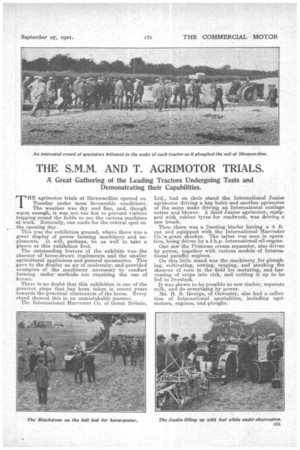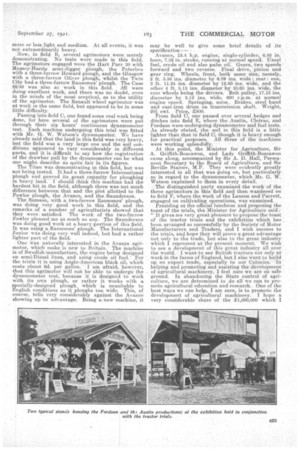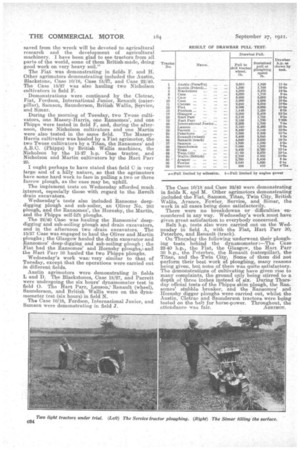THE S.M.M. AND T. AGRIMOTOR TRIALS.
Page 21

Page 22

Page 23

Page 24

If you've noticed an error in this article please click here to report it so we can fix it.
A Great Gathering of the Leading Tractors Undergoing Tests and Demonstrating their Capabilities.
THE agrimotor trials at Shrawardine opened on Tuesday under most favourable -conditions. The weather was dry and fine, and, though warm enough, it was not too. hot to prevent visitors tripping round the fields to see the various machines at work. Naturally, one made for the central spot on
the opening day. This was the exhibition ground, where there was a great display of power farming machinery and implements. It will, perhaps, be as well to take a glance at this exhibition first.
The Outstanding feature of the exhibits was the absence of horse-drawn implements and the smaller agricultural appliances and general accessories. This gave to the display an air of modernity, and provided examples of the machinery necessary to conduct farming under. methods, not requiring the use of horses:
There is no doubt that this exhibition is one of the greatest steps that has been taken in recent years towards the practical elimination of the horseEvery stand showed this in an unmistakable manner.
The International Harvester Co. of Great Britain, Ltd., had on their stand the International Junior agrimotor driving a hay baler and another agrimotior of the same make driving an International ensilage cutter and blower. A third Junior agrirnotor, equipped with rubber tyres for roadwork, was driving a saw bench.
Then there was a Deering binder having a 6 ft. cut and equipped with the International' Harvester Co.'s, grain shocker. The latter was seen in operation, being driven by a 3 h.p. International oil-engine.
One saw the Primrose cream separator, also driven by power, together with various models of International paraffin engines.
On this little stand was the machinery for ploughing, cultivating, sowing, reaping, and stooking the sheaves of corn in the field for maturing, and harvesting of crops into rick, and cutting it up to be fed to livestock.
It was shown to be possible to saw timber, separate milk, and do everything by power. Mr. IL B. George, of Oswestry, also had a collection of International specialities, including agrimotors, engines, and ploughs. Renault, Ltd., on their .stand exhibited their agrimotors, both wheel and caterpillar models. As these machines will be dealt with later, there is no necessity to dwell upon the matter here.
A great collection of power instruments was to be found on the stand of kansonce, Sims and Jefferies, Ltd. These included a threshing machine of medium size and the famous 42 in. Homestead thresher, which can be driven by quite a small engine, the British Wallis agrimotor, the Wizard.high-compression pertable oil-engines, and models of all other well-known ploughs and cultivators.
The Revolt drain excavator, in two sizes, namely, 7 in. and 14 in., constituted the interesting exhibit of the South Lincolnshire Agricultural Engineering Co., Ltd.
The Saunderson Tractor and Implement Co.'s stand was full of interest. It was similar to what we have seen at the various summer shows, and included the Sauederson agrimotors, ploughs, grubbers, fuel tank wagon, drilling wagon, agrimotor accessories, and Marshall thresher.
'The Austin agrimotor stand and that of the Ford Co. were very attractively arranged. On the stand of the Ancona Motor Co., Ltd., were-agrimotors of the British Wallis and Samson make, J. I. Case ploughs, disc harrows, and Ransomes' and Hornsby ploughs, The working parts of the. 10-18 h.p. Case tractor were exposed on the stand of the J. I. Case Threshing Machine Co.
Interesting stands were arranged by H. G. Burford and Co., Ltd., and Ruston and Hornsby, Ltd. Large collectiOns of implements Were to be found on the stand of -R. A. Lister. and:Co.; Ltd., E. V. Twose, Phipps and Son, Win. CorbetNicholas, W. N. Nicholson and Sens., Ltd., Fairbanks Morse and Co., and others.
The site of the agrimotor. trials at Shrawardine covered roughly about 400 or 500 acres of land with the Severn as outside boundary along one side. The exhibition field was a very fine green meadow in front of Shrawardine Castle, the homestead of Mr. and Mrs. Win. .Everall's country seat.. Most of the land Upon which the trials were being conducted belongs to Mr. Everall, but some of the fields belong to the farms of Mr. C. S. Fawcett, of Ensdon, and Mr. E. J. Pryce, of Felton Butler. The land stands high and c32 falls away to the Severn with the Bredon range of hills beyond and the Berwyna to the north. Many countries were officially represented at the trials, for there were present representatives of the Governments of Sweden, Norway, Denmark, Belgium, and France. There are also representatives from the Malay States' Rhodesia, •America, British War Office, and India Office, and representatives of the Ministry of Agriculture have been watching the trials the whole time.
The scheme of the trials ensured that every tractor should undergo an official ploughing test occupying six hours in the morning and six hours in the afternoon. Demonstration ploughing, belt horse-power tests, hauling cultivators and harrows occupied the remainder of the trial period. Thus, any visitor would, bar mishaps, be able to rely always upon seeing all of the machines at work. Great credit is due to the responsible officials of the S.M.M. and T. for the excellent manner in which the arrangements were made and carried out. Judging by the fact that everything was ready for Tuesday morning and that the agrimotors commenced their work with promptitude, one can easily understand that a good deal of work had fallen to the lot of someone during the week-end.
Drawbar teats Were made, and the results are given in the table on page 184. This table is very useful -. • in a way, but one has to read with a certain amount . of give and take. As: Will be seen; in some cases, the test gave the power of the engine on the drawbar test, but, • in those cases where the pull was limited' by adhesion, the soil conditions govern the whole results. In other words, the drawbar pull would vary with the conditions Of the soil. To come to the actual work of the agrimotors on Tuesday, the fields were conveniently. scheduled according to the letters of the alphabet. Field A is the site of the power farming exhibition. ., The soil in B was Very light and used merely for demonstration purposes. . • . The soil in C. was as heavy as one might expect to find soil.
In field E the soil was also heavy, but not so bad as in C.
In the other fields one might say that the soil was more or less light and medium. At all events, it was not extraordinarily heavy.
Now, in field B, several agrimotors were merely demonstrating. No tests were made in this field. The agrimotors engaged were the Hart Parr 30 with Massey-Harris semi-digger plough, the Peterbro with a three-furrow Howard plough, and the Glasgow with a three-furrow Oliver plough, whilst the Twin City had a three-furrow Ransomes' plough. The Case 22/40 was also at work in this field. All were doingexcellent work, and there was no doubt, even in the minds of the most sceptical, as to the utility of the agrimotor. The Renault wheel agrimotor was at work in the same field, but appeared to be in some little difficulty.
Passing into field 0, one found some real work being done, for here several of the agrimotors were put through their six hours' continuous dynamometer test. Each machine undergoing this trial was fitted with Mr. G. W. Watson's dynamometer. We have already said that the land in this field was very heavy, but the field was a very large one and the soil conditions appeared to vary considerably in different parts, and it is difficult to say how the registration of the drawbar pull by the dynamometer can be what one might describe as quite fair in its figures. The Titan was, demonstrating in this field, but was not being tested. It had a three-furrow International plough and proved its great capacity for ploughing in heavy land. should think this machine had the hardest bit in the field, although there was not much difference between that and the plot allotted to the Fowler plough, the Avance and the. Saunderson.
The Samson, with a two-furrow Ransomes' plough, was doing very good work in this field, and the remarks of a number of agriculturists showed that they were. satisfied. The work of the two-furrow Fowler pleased me as much as any. The Saunderson was doing good work at a. heavy portion of this field. It was using a. Ransomes' plough. The International Junior was doing very well indeed, but had a rather lighter part 'of-the field.
One was naturally interested in the Avanpe agrimotor, which make is new to Britain. The machine is of Swedish manufacture, the engine being designed on semi-Diesel lines, and using crude oil fuel. For the trials it is using Anglo-American black oil, which costs about 6d. per gallon.' I am afraid, however, that this agrimotor will net be able to undergo the dynamometer test,' because it is designed to Work with its own plough, or rather it works with a specially-designed plough, which is unsuitable to English conditions as it ploughs too wide. This, of course, tells very considerably against the Avance showing up to advantage. Being a-new machine, it
may be well to give some brief details of its specification :—
Avance,13.4 h.p. engine, single-cylinder, 6.85 in. i bore, 7.32 n. stroke, running at normal speed. Usual fuel, crude oil and also palm oil. Gears, two speeds forward and two reverse. Final drive, pinion and gear ring. Wheels, front, both' same size, namely, 2 ft. 3.56 ins, diameter by 6.89 ins. wide ; rear : one, 3 ft. 11.24 ins, diameter by 12.80 ins, wide, and the other 4 ft. 5.15 ins, diameter by 10.63 ins, wide, the rear wheels being the drivers. Belt pulley, 17.13 diameter by 5.12 ins. wide, 600 r.p.m. at normal engine speed. Springing, none., Brakes, steel band and cast-iron drum on transmission shaft. Weight, 201. cwt. Price, 1500. From field 0, one passed over several hedges and ditches into field E, where the Austin, Cletrac, and Fordson were undergoing dynamometer and fuel tests. As already stated, the soil in this field is a little lighter than that in field 0, though it is heavy enough for practical purposes. All three of the machines were working splendidly. At this point, the Minister for Agriculture, Sir A. Griffith-Boseawen, and Lady Griffith-Boscaweu came along, accompanied by Sir A. D. Hall, Permanent Secretary to the Board of Agriculture, and Sir Seville Stainer, M.P. They were evidently greatly interested in all that was going on, but particularly . so in regard to the dynamometer, which Mr. G. W. Watson explained to them in. every detail.
The distinguished party examined the work of the three agrimotors in this'field and then wandered on to field F, where the work of the Lauson and Parrett, engaged on cultivating operations, was examined.
Presiding at the official luncheon and proposing the toast of the trials, the Minister for Agriculture said : " It gives me very great pleasure to propose the toast of the tractor trials and the exhibition which has _ been arranged so successfully by the Society of Motor Manufacturers and Traders, and I wish success to the trials, and hope they will prove a great advantage not only to the trade, but also to the great industry which I represent at the present moment. We wish to see a development of this great industry all over the world. I want to see British tractors net only 'at work in the farm's of England, but I also want to build up an export trade., especially to our Colonies. -.In helping and promoting and assisting the development of agricultural machinery, I feel sure we are on safe ground. In abandoning the State control of agriculture, we are determined to do all we can to promote agricultural education and research. One of the best ways we can help, I am sure, is to promote the development of agricultural machinery. I hope a very considerable. share of the £1,000,000 which I
saved from the wreck will be devoted to agricultural research and the development of agricultural machinery. I have been glad to see tractors from all parts of the world, some of them British-made, doing good work on very heavy soil."
The Fiat was demonstrating in fields F. and H. Other agrimotors demonstrating included the Austin, Blackstone, Case 10/18, Case 15/27, and Case 22/40. The Case 15/27 was also hauling two Nicholson cultivators in field F.
Demonstrations were continued by the Cletrac, Fiat, Fordson, International Junior, Renault (caterpillar), Samson, Saunderson, British Wallis, .Service, and Simar.
During the morning of Tuesday, two Twose cultivators, one Massey-Harris, one Ransomes', and one Phipps were tested in field F, and, during the afternoon, three Nicholson cultivators and one Martin were also tested in the same field. The MasseyHarris cultivator was hauled by a Fiat agrimotor, the two Twose cultivators by a Titan, the Ransomes) and A.B.C. (Phipps) by British Wallis machines, the Nicholson by the 15-27 h.p. Case tractor, and Nicholson and Martin, cultivators by the Hart Parr 20.
I ought perhaps to have stated that field C is very large and of a hilly nature, so that the agrimotors have some hard work toface in pulling a two or three furrow plough, as the case may be, uphill.
The implement testa on Wednesday afforded much interest, especially those with regard to the Revolt drain excavators.
Wednesday's tests also included Ransome deepdigging plough and sub-sailer, an Oliver No. 283 plough, and the Ransomes', the Hornsby, the Martin, and the Phipps self-lift ploughs. The 22/40 Case Was hauling the Ransomes' deepdigging and sub-soiling plough and drain excavators, and in the afternoon two drain excavators. The 15/27 Case was engaged to haul the Oliver and Martin ploughs ; the Glasgow hauled the drain excavator and Ransomes' deep-digging and sub-soiling plough ; the Fiat had the Ransomes' and Hornsby ploughs, i and the Hart Parr 30 hauled' the two Phipps ploughs. Wednesday's work was; very similar to that of Tuesday, except that -the operations were carried out in different fields.
Austin agrimotors were demonstrating in fields L and D. The Blackstones, Case 15/27, and Parrett were undergoing the six hours' dynamometer test in field 0. The Hart Parr, Lauson, Renault (wheel), Sannderson, and British Wallis were on the dynamometer test (six hours) in field N. The Case 10/18, Fordson, International Junior, and Samson were demonstrating in field J.
The Case 10/18 and Case 22/40 were demonstrating in fields K. and M. Other agrimotors demonstrating included the Fiat, Samson, Titan, Twin City, British .Avance, Fowler, Service, and Simar, the work in all cases being done satisfactorily. There were no breakdowns or difficulties encountered in any way. Wednesday's work.must have given great satisfaction to everybody concerned.
Belt h.p. tests also were carried out on the Wednesday in field A, with the Fiat, Hart Parr 30, Peterbro, and Renault (track). On Thursday the following underwent their ploughing tests behind the dynamometer:—The Case 22-40 h.p., the Fiat, the Glasgow, the Hart Parr 30 h.p., the Peterbro, the Renault (caterpillar), the Titan, and the Twin City. Some of them did not perform their best work at ploughing, many reasons being given, but none of them was quite satisfactory. The demonstratians of cultivating have given-rise to many complaints, the ground only being stirred to a depth of three inches instead of six. During Thursday official tests of the Phipps skim plough, the Ransomes' stubble breaker, and the Ransomes' and Hornsby digger ploughs were carried out, whilst the Austin, Cletrac and S' aunderson tractora were being tested on the belt for horse-power. Throughout, the attendance was fair. A GRIMOT.


































